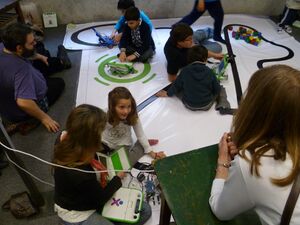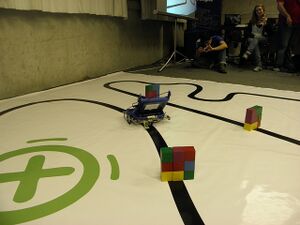Proyecto Butia 2.0: Difference between revisions
No edit summary |
No edit summary |
||
| (12 intermediate revisions by 2 users not shown) | |||
| Line 1: | Line 1: | ||
[[File:butia1.jpg|thumb|butiá workshops]] |
|||
| ⚫ | |||
| ⚫ | |||
| ⚫ | |||
| ⚫ | |||
[[File:butia2.jpg|thumb|butiá challenge at sumo.uy]] |
|||
| ⚫ | |||
| ⚫ | |||
science with the XO computer. |
|||
The main idea is to extend the actuation and sensorial capabilities of the XO and reuse the software and hardware present in it in order to transform |
|||
the XO in a mobile low cost robot. |
|||
| ⚫ | Students can program their own robot using the existing activities in the XO computer like [http://activities.sugarlabs.org/es-ES/sugar/addon/4434 Tortugarte Butiá], [http://activities.sugarlabs.org/es-ES/sugar/addon/4457 Butialo], Pippy, Chat and in the near future Scratch and others. The kit consists of a laser-cut |
||
| ⚫ | |||
| ⚫ | |||
In September 2010, 28 robots were gave to secondary schools of Uruguay, this year they came to participate in [http://www.fing.edu.uy/inco/proyectos/butia/mediawiki/index.php/Review robotics challenges] using the butiá robot they own. Nowdays we are working with children in workshops and developing the 2.0 version of the butiá robot and looking for financial support to continue giving robots to public educational centers and making workshops for students. |
|||
| ⚫ | |||
Latest revision as of 11:33, 4 November 2011
Project Butiá aims to create an inexpensive open source educational platform to teach robotics and computer science with the XO computer. The main idea is to extend the actuation and sensorial capabilities of the XO and reuse the software and hardware present in it in order to transform the XO in a mobile low cost robot. Students can program their own robot using the existing activities in the XO computer like Tortugarte Butiá, Butialo, Pippy, Chat and in the near future Scratch and others. The kit consists of a laser-cut wheeled platform were the XO sits on, and a set of sensors and actuators to which it connects. It's designed to promote a constructive use, allowing to select where to put sensors in the plataform using perforated pieces provided with the kit. The project is maintained by the Computer Science Institute of the Universidad de la Republica, the State University of Uruguay. In September 2010, 28 robots were gave to secondary schools of Uruguay, this year they came to participate in robotics challenges using the butiá robot they own. Nowdays we are working with children in workshops and developing the 2.0 version of the butiá robot and looking for financial support to continue giving robots to public educational centers and making workshops for students.
For more information please visit Butiá Project or the Butiá Wiki

